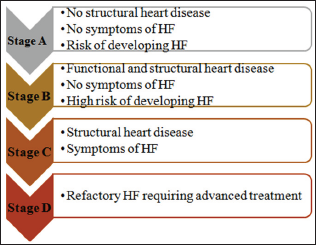Lupine Publishers| Journal of Biomedical Engineering and Biosciences
Mini Review
Heart Failure Prevalence and Cost
Heart failure (HF) is a growing epidemic that affects about six million people in the United States and more than 23 million worldwide [1,2] .The prevalence of HF is greatest among people aged 65 years or older and has been increasing with the growth of this demographic population [3-6]. Around 50% and 90% of patients with HF die within 5 and 10 years of diagnosis, respectively [1]. Total medical costs attributable to diagnosis, treatment, and prevention of HF in the developed countries are approximately 1% - 2% of the total health care expenditure [7-9]. In the United States, total costs for HF care are more than $39 billion annually [2].
Heart Failure Symptoms and Etiology
HF patients suffer from structural or functional heart disease that impairs the ability of the ventricle to fill with or eject blood [10,11]. The symptoms of HF are shortness of breath/orthopnea/ dyspnea, fatigue, weakness, pulmonary congestion, edema, nocturnal cough, and evidence of a decrease in myocardial performance at rest [12,13]. Some of the etiologies that may lead to HF, are myocardial ischemia, hypertension, cardiomyopathies, valvular heart disease, obesity, pulmonary hypertension, abnormal myocyte calcium cycling, excessive or inadequate proliferation of the extracellular matrix, excessive neuro-humoral stimulation, accelerated apoptosis and genetic mutations congenital heart disease [8,11,14].
Heart Failure Types
Classification of HF can be based on the left ventricular Ejection Fraction (EF): HF with Reduced EF (HFrEF) and HF with Preserved EF (HFpEF). In HFrEF patients, the heart is not able to pump enough blood into the circulation due to ventricular systolic dysfunction. The EF in these patients is less than or equal to 40% [15]. HFpEF is primarily caused by LV diastolic dysfunction (impaired relaxation during LV filling) due to the stiffening of the LV wall with EF>50% [8,16,17]. In addition to this classification schemes, HF can be classified based on ACCF/AHA stages of HF (Figure 1) [10].
Figure 1: ACCF/AHA Stages of HF.

Heart Failure Treatments
The goal of HF treatment is to reduce the morbidity and mortality in these patients. For stage A and B, changing lifestyle (e.g. regular exercise and restriction of sodium intake), and using antihypertensive agent are recommended [8,10,15]. For stage B, C, and D, pharmacological therapy including diuretic- based antihypertensive therapy, spironolactone, ACE inhibitors, angiotensin receptor blockers, Beta blockers, aldosterone antagonists, hydralazine and isosorbide dinitrates, digoxin, and anticoagulation are recommended. Advanced HF stage might need surgical treatment methods including coronary revascularization, mitral valve repair, ventricular reconstruction, and heart transplantation [8,18].
Read More About Lupine Publishers Journal of Biomedical Engineering and Biosciences Please Click on Below Link: https://biomedical-sciences-lupine-publishers.blogspot.com/

No comments:
Post a Comment
Note: only a member of this blog may post a comment.